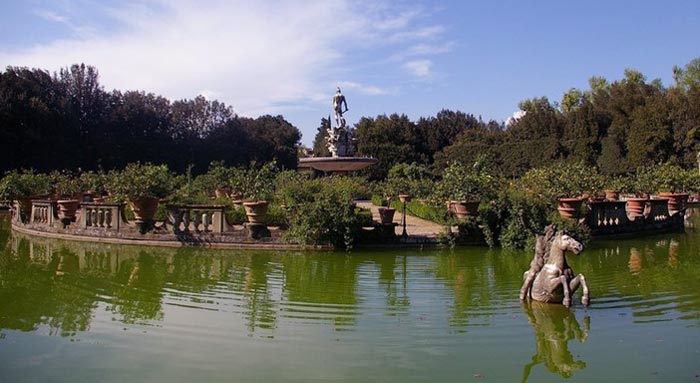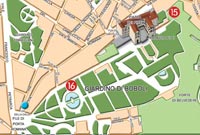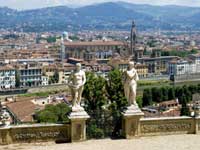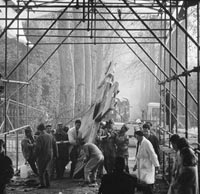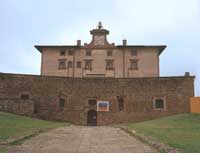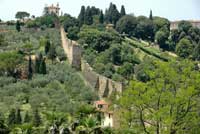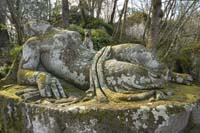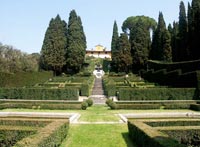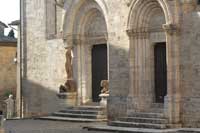I Giardini di Boboli (Boboli's Gardens) |
Italian art city par excellence, Florence is also a surprisingly green metropolis, home to numerous splendid gardens. Annexed to the Palazzo Pitti Museum complex, the Boboli Garden is one of the most famous formal 16th century Italian gardens and a veritable open air museum, with a unique architectural plan and dozens of statues hiding amidst the multicoloured plants. The garden has a triangular plan, with two, steeply sloping orthogonal axes, which terminate in the Bacino di Nettuno (fountain of Neptune). The creation of artificial grottoes was an introduction of Mannerist style to Italian, and then to French, gardens of the mid 16th century. Two famous grottoes in the Boboli Gardens of Palazzo Pitti were begun by Vasari and completed by Ammanati and Buontalenti between 1583 and 1593. The lemonscent is always in the air, as the Boboli gardens has a great collection of old lemonplants in terracotta pots. In the winter the lemonplants are brought to the 'limonaia' where they are protected against the winter cold. The Boboli gardens lie directly behind the Pitti Palace and were created for the Medici when they moved in during 1550. They really are spectacular because of the mixture of art and gardens sitting together, side by side, in harmony. |
|||
In 1766 the gardens were opened to the public and in 1992 a small entrance fee was introduced but this is so small as to be negligible. It is a haven of peace and quiet in a very noisy city and the views over Florence and the Tuscan countryside are breathtaking. The gardens were originally designed by Niccolò Pericoli but after his death a variety of people had a hand in completing the gardens including Davide Fortini, Giorgio Vasari and Bartolomeo Ammannati. Despite this, the original design was followed and the gardens have pretty much remained the same ever since. The entrance to the gardens leads directly to the amphitheatre with the fountain designed by Giambologna. This was where the first ever opera performance was held and it is quite an impressive sight. |
|||
Boboli Gardens are still distinguished by a number of important statues by Giambologna, in particular the Fontana dell'Oceano created in 1574 – 7 but moved to the Isolotto by Parigi. Other famous sculptures include the Nano Morgante by Valerio Cioli (1529 – 99), a naked fat dwarf riding a tortoise, supposedly an allegory of laziness and wisdom. |
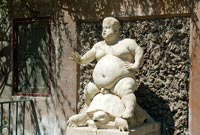 La Fontana del Bacchino |
||
Its creation and development spans four hundred years between the 15th and 19th centuries. The gardens laid out behind Santa Felicita in Oltrarno by the Borgolo family, the name from which Boboli is thought to derive, were bought in 1418 by Luca Pitti. In the mid-15th century Pitti commissioned the construction of a grand palace, which is believed to have been designed by Luca Fancelli,with the help of his master Filippo Brunelleschi. In 1549 the property was bought by Cosimo I’s wife Eleonora da Toledo, and became the Medici family’s city residence. Niccolò Tribolo was engaged to design the gardens, and it is probably he who excavated the hill to create the Amphitheatre, a highly successful creation in both perspective and functional terms.It created the garden’s first perspective vista (running north-west/south-east), a prospect that began at the main entrance to the palace and continued across to the hill and all the way to Forte Belvedere. When Tribolo died, work continued under the direction of Bartolomeo Ammannati (15111592) and subsequently Bernardo Buontalenti (1555-1635).In the 17th century Giulio Parigi (1568-1635) and his son Alfonso devised the second perspective vista,which was to run at right angles to the first,in the direction of Porta Romana.The triangular garden has two orthogonal axes which meet roughly at the Fountain-Basin of Neptune; the steeply sloping avenues run across the central walk and are organised as a series of terraces with smaller avenues, footpaths, sculptures or landscaping elements leading to specific garden features:glades,enclosed gardens or buildings.The visit begins at the fountain featuring the statue of a dwarf riding a tortoise,sculpted in 1560 by Valerio Cigoli (1529-1599). Opposite the entrance is the Buontalenti Grotto,a series of three communicating chambers: the first, with stuccowork decorations, is characterised by pastoral scenes executed by Bernardino Poccetti (1542-1612); the second contains a marble statue group depicting the abduction of Helen by Paris, sculpted by Vincenzo Rossi da Fiesole (1525-1587); the third, frescoed by Poccianti,has a fine fountain by Giambologna (1529-1608) depicting Venus emerging from the water after bathing.Beyond the statues of the Dacian Prisoners, the route through the gardens continues and,next to the rising avenue,passes the Jupiter Garden with a seated statue of Jupiter and the adjoining Madama Garden.The avenue leads up to the grand Amphitheatre and the Artichoke Fountain, whose large octagonal basin is decorated with numerous statues and crowned by a bronze artichoke by Francesco Susini. The great horseshoe-shaped sweep of the amphitheatre was possibly originally conceived as a piece of landscaping, and in 1599 was embellished with steps (still in existence) topped by aedicules with niches containing bronze statues and terracotta urns. The granite basin is taken from the Baths of Caracalla, while the obelisk, which arrived in Rome in 30 BC from Egypt, was brought to Boboli in 1790 by Pierre Léopold,who commissioned Gaspero Paoletti (1727-1813) to design a plinth adorned with bronze tortoises; it was erected at the centre of the amphitheatre in 1841. The main avenue leads to the Bacino di Nettuno reached by a dual ramp, at the beginning of which stand three Roman statues.The basin is dominated by the bronze statue of Neptune by Lorenzi (1534-1583):the ancient god of the sea stands on a rocky spur decorated with naiads and tritons, at the centre of a large fountain-basin surrounded by stepped turfed terraces,at the top of which, among holm-oaks, stands the colossal statue of Abundance,sculpted in around 1636 by Pietro Tacca. Here, at the point where the ancient city walls once stood,the original garden came to an end. On a cavaliere, or rampart of the walls built by Michelangelo in 1529,stands the Giardino del Cavaliere, reached by a double staircase, at either side of which stand two statues of the Muses.The niches contain statues of Flora and Jupiter, early works by Giovanni Caccini.At the centre of the garden, which is bordered by low box hedges,stands a fountain with a central marble cherub. This ornamental work is known as the “monkey fountain”because of the three bronze primates at its base. Underneath the Casino del Cavaliere building is a large water storage area known as the trout reservoir, from which the pipes that supply water to the entire garden lead off.To the east of the Amphitheatre, near the Statue of Abundance is the Kaffeehause, a Rococo-style pavilion by Zanobi del Rosso, with a characteristic glazed dome.This small building stands on a stepped lawn at the centre of which is the 17th-century Ganymede Fountain. The Kaffeehause can be considered to be the visual focal point of the park’s second main thoroughfare, the steeply descending Viottolone. The beginning of this avenue is marked by two statues known as the “Greek Tyrannicides” and its route is lined on both sides by ancient statues,mainly Roman or 18th century.Three smaller avenues leading off at right angles from the Viottolone divide the garden, which has seen a number of changes over the centuries, including the laying out of the Labirinto,the maze which was destroyed in 1832 (except for the central basin) to make way for a new coach road.The first side avenue consists of a pergola of holmoaks with low stone seats at the sides; at the junction with the Viottolone are four marble statues by Giovanni Caccini: Prudence, Aesculapius,Autumn and Summer; the walk terminates on the right-hand side with the Fountain of Oceanus. The second branching alley ends at the city walls with a Bust of Jupiter (attributed to Giambologna), while the point where it crosses the Viottolone is marked by three Roman statues (the Senator, Bacchus and the Bald Philosopher) and one from the 18th century. Further down, the junction with the third side avenue has six statues:Aesculapius,Andromeda, a Nymph, Modesty and two groups with two peasant girls,known as the Gioco dello Scaccomazzone and the Gioco della Pentolaccia.At the end of the Viottolone the steep perspective ends at the elliptical Vasca dell’Isola,constructed by Parigi’s family in 1618.12-metre-high espaliers of ilex form the backdrop to numerous stone and marble statues with mythological, historical or popular themes,occupied almost entirely by a large basin connected to the ground by two walkways, entered through a wrought-iron gate. At the centre of the pool stands the Fountain of Oceanus, a copy of the original work by Giambologna. It consists of a statue of Neptune over statues representing the Nile, the Ganges and the Euphrates pouring their waters into the Ocean, a pool of Elba granite,the base of which is embellished by bas-reliefs. Emerging from the water of the island are the marble groups of Perseus on horseback and of Andromeda,whose ankles are chained to the rock.In line with the main avenue are the Fountain of the Harpies and the Fountain of the Putti. The Viottolone – after a division by a side avenue with four ancient statues of Serapis,Jupiter,a Male God and the Emperor Claudius – leads to the hemicyclical Prato delle Colonne,a lawn surrounded by a tall hedge with twelve niches containing large busts and with two red granite columns at the centre supporting marble vases. The Porta Romana gateway stands in an open space containing various stone groups. The Fontana della Botticella near the iron gate is a fountain with a statue of a peasant pouring water from a small barrel,on a Roman sarcophagus base. On the path alongside the boundary wall towards Via Romana and leading back up to Palazzo Pitti is a series of statues running up to the Limonaia, a hothouse that is a remodelling of an earlier building erected in 1785 by Zanobi del Rosso. Near the large gateway on Via Romana is the Palazzina d’Annalena,a small neo-classical building by Cacialli. The Meridiana (or Sun-Dial) building next to Palazzo Pitti is a Neoclassical work by Gaspare Maria Paoletti (1778) and Pasquale Poccianti. The Prato della Meridiana in front of this building is a large,steeply-sloping lawn, from which smaller avenues dotted with statues lead off. |
|||
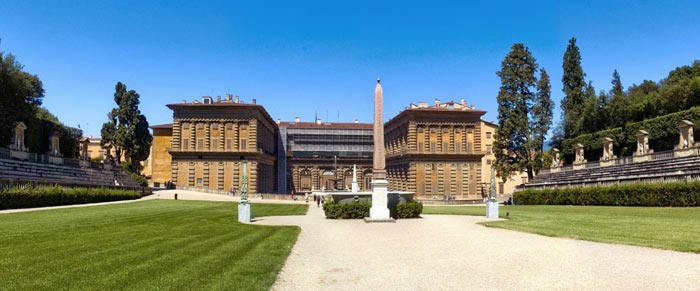 |
|||
| Palazzo Pitti, seen from Boboli gardens |
|||
The more famous Grotto del Buontalenti (recently under restoration), begun in 1557 and completed between 1583 and 1593 by Ammanati and Bernardo Buontalenti, is more complex, representing the world of ancient mythology and the forces of nature. In 1587 its façade was decorated by Giovanni del Tadda with rustic figures. Inside a series of stalactites and tufa sculptures represented the myth of Deucalion and Pyrrha and surrounding walls had frescoes by Bernardino Poccetti. In the third room there is a marble statue of Venus by Giambologna. Water drops and jets cool the air. Recently, under Dottore Giorgio Galleti, the gardens and grottoes have been under restoration, with hedges cut back to original heights and a programme of replanting, especially of the Isolotto with old rose species. In front of the Limonaia, where the Medici had their collections of rare citrus, beds edged with low box are planted with historic 16th-century flowers. High hedges and tunnels of holm oak, bay laurel, Phillyrea, Rhamnus, myrtle, and laurustinus define the pathways and provide dark shady walks. Vasari Corridor (Corridoio Vasariano) |
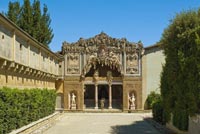 Dome of the Grotta del Buontalenti in Boboli Gardens. On the left the door to Vasari Corridor |
|
The Corridor was built in 1564 by Giorgio Vasari in only five months at the time of the wedding between Francesco I de' Medici and Giovanna of Austria; it served to link up the Pitti Palace, where the Grand Duke resided, with the Uffizi (or offices) where he worked. It is a covered walk, almost a kilometre in length, an overhead passageway that starts out from the West Corridor of the Gallery, heads towards the Arno and then, raised up by huge arches, follows the river as far as the Ponte Vecchio, which it crosses by passing on top of the shops. The meat market on the bridge was at this time trasferred elsewhere, so as not to offend the Grand Duke's sensitive nose with unpleasant smells on his walk, and replaced (from 1593) with the goldsmiths who continue to work there today. On the other side of the Arno, the corridor passes through the interior of the church of Santa Felicita, Down the tops of the houses and the gardens of the Guicciardini family until it finally reaches the Boboli gardens (one of the exits stands beside Buontalenti's Grotto) and the apartments in the Pitti Palace. Vasari thus created a monumental urban footpath that took the absolute power of the ruler right into the historic heart of the city. In fact, a second corridor above Via della Ninna links the other side of the palace of the Uffizi with Palazzo Vecchio, the seat of Florentine government since the 13th century. The Arno flood of 1966 also tested the bridge's resilience and swept parts of it away in its powerful current. The most affected sections were the overhanging shops belonging to the gold and silversmiths. |
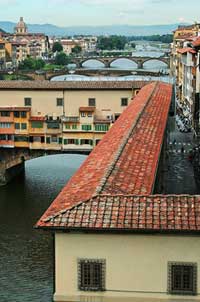 The West Corridor of the Gallery |
|
At the southern end of the broad avenue, viale della limonaia, which leads one back to the Pitti Palace, is the Lemon House. Designed by Zanobi del Rosso, who is also responsible for the Kaffeehaus, it was erected in 1777-78 as part of Peter Leopold's renovations of the Garden. The building retains the colorful original rococó stucco which once characterized many Florentine structures. It was built where the Medici once kept a menagerie of rare animals. The Limonaia was intended to house rare and interesting citrus plants and today it still houses a collection started by the Medici. The Medici held citrus in high regard, for their reputed medicinal and therapeutic qualities as well as for their beauty and uniqueness of certain citrus plants. The Knights garden which stands almost at the top of the Boboli gardens is well worth the long climb. Instead of a view over the city, this vantage point gives views of the Florentine hills. The contrast between the city on one side and the countryside on the other is quite marked and represents how much Florence was a self-contained unit within Tuscany. There is none of the sprawling on the outskirts of the city that we have become so inured to in the UK. The ramparts of the Knights garden were designed by Michelangelo in 1529 and completes the medieval feel. The grottos are wonderful, mostly done in a roccoco style and based around characters from either the Bible or from Roman mythology. Three of them are worth the extra effort to see: the Adam and Eve grotto, the grotto with Bacchus and the tortoise and the Grotto Grande by Michelangelo Buontalenti. |
||
The magnificent Giardino dei Semplici, the city's Botanical Garden. Founded in 1545 by Cosimo I de' Medici, the garden extends over more than two hectares of land, most of which covered by greenhouses. Today, the Botanical Garden continues to cultivate numerous varieties of officinal plants, the so-called semplici, after which the garden was named. At the center of the garden, a stone fountain with water-spitting putto takes pride of place amidst ponds home to an amazing collection of aquatic plants. |
||
The Torrigiani Garden, not far from the Bobolino, is a private property open to the public. The garden was designed by Luigi Cambray-Digny and completed by Gaetano Baccani who, in the 19th century, added the neo-gothic tower which has become the garden's hallmark. On the summit of the tower there is a small observatory from where to admire the stars. |
||
Parco delle Cascine Originally a wild rural area, now a park open to the public with dedicated areas for sporting activities. |
||
| Bobolino Not far away from the Boboli Garden we find its smaller twin, the Bobolino, a public park structured like a hanging garden and characterised by grassy slopes, ponds and artificial caves. Less famous than its "big brother" (Boboli) Bobolino is the name under which some green spaces are called included in the first area from Porta Romana going up to the Piazzale Michelangelo. It is not exactly a garden, but you can find trees, flower beds and a large tub with jets. In spring and summer it becomes a destination for both people looking for a cool place to rest and for newlywed couples who want to enrich their photographic service including glimpses of unknown Florence. |
||
| The Giardino Bardini is an Italian Renaissance garden in Florence, Italy. Only opened recently to the public, it is relatively little-known. Villa Bardini is close to the Boboli garden and can be visited on the same ticket. The garden boasts many statues and panoramic views over the city. Wildlife in the garden includes rock pigeons, blackbirds and woodpigeons. Access is gained via the Via de' Bardi, just over the road from the Museo Bardini in the Oltrarno district of the city, although the gardens exit onto the Costa di San Giorgio, onto which the Forte di Belevedere and the Giardino di Boboli connect in turn. The fortress of Belvedere, located on the hill behind the garden of Boboli, is often referred to as «the most beautiful terrace on Florence». Art exhibitions and summer festivals are held here. Gardens in Tuscany | The Bardini Garden in Florence |
|
||||||||||||||||||||||||||||||||||||||||||||||||||||||||||||||
| [1] The symbol of the devastating effects of the flood is the almost complete destruction of the huge Crucifix by Cimabue. The crucifix, painted in distemper on wood (around 1272) by one of the most significant painters of the 13th century, had lost the majority of its layer of paint. The first action taken was to move this work of art from the former Santa Croce refectory to the Limonaia,the Lemon Garden in the Giardino di Boboli. In 1976, the Crucifix underwent a major restoration, during which it was possible to conserve the remains of the layer of paint. Art in Tuscany | Cimabue, Crucifix of Santa Croce at Florence The Kunsthistorisches Institut in Florence | The Flood of 1966 | Santa Croce | Cimabue’s Crucifix |
||||||||||||||||||||||||||||||||||||||||||||||||||||||||||||||
| I Giardini di Boboli opening hours: Daily: Entry is permitted up to an hour before closing time. Closed on the 1st and the last Monday of each month, New Year's Day, May 1st and Christmas Day. The Grotta Buontalenti is open for accompanied visits, depending on the opening hours of the Gardens: Ticket valid also for the Museo degli Argenti, the Costume Gallery, the Porcelain museum and the Bardini Gardens. |
||||||||||||||||||||||||||||||||||||||||||||||||||||||||||||||
| The Pitti Palace (Palazzo Pitti)The Pitti Palace, which was formerly the residence of the grand-dukes of Tuscany and later of the King of Italy, now houses several important collections of paintings and sculpture, works of art, porcelain and a costume gallery, besides providing a magnificently decorated historical setting which extends to the Boboli Gardens, one of the earliest Italian gardens famous also for its fountains and grottoes. It comprises the following galleries and museums: The Palatine Gallery, The Gallery of Modern Art, The Costume Gallery, The 'Museo degli Argenti' (The Medici Treasury), The Porcelain Museum and The Boboli Gardens. When the rich Florentine merchant Luca Pitti died, the palace on the other side of the Arno was still unfinished. It was never proved that Brunelleschi was the author of this Palace. What is known for sure, though, is that the building was much smaller than the present one. At that time, Florence was governed by Pitti's implacable adversaries, the Medici, and destiny was to have it that the building end up in their hands when the rich wife of Cosimo 1 bought it with the park and square lying in front of it as the House's official home in 1550. Palazzo Pitti, opening on to the Boboli gardens, was a more prestigious and appropriate alternative for the Medici than their residence in Palazzo Vecchio, still the symbol of Florence's Republican past. Cosimo and Eleonora decided to turn it into a princely palace and charged Bartolomeo Ammannati with completing and, above all, enlarging the building. By doubling its internal volume depth and adding side wings, this bare 15th century building was transformed into the most monumental of the late Renaissance Florentine buildings. The Medici did not, in fact, move into it stably until many decades later and the Palace was used as a kind of representative hotel for ambassadors and kings besides being the place where they held the court's worldly events. Furthermore, to make the Palace easier to reach without having to mix with the crowds, Cosimo charged his architect and artistic consultant Giorgio Vasari with the building of a raised passageway connecting it to Palazzo Vecchio (the so-called Vasarian Corridor) It only became the official Medici residence in 1589 with Ferdinando I and Cristina of Lorraine and over the centuries Pitti Palace housed another two dynasties: the Lorraine one and the Savoy one. Its growth and enlarging are due to the changed use for this building and represent the culture and taste of an ample period of time, from late Renaissance to our days. Its sumptuous decorations, extraordinary art collections continuously added to over the years, its art objects, fountains, rare plants in the Boboli Gardens have told the story of this spectacular building over the centuries. A fundamental event in the palace history was the Leopold Hapsburg Lorraine decision to open the west wing, seat of the ancient Medici apartments, to the public where they organized the works of the different Medici collections (while the court carried on living in the east wing). The Palatine Gallery opened to the public in 1834. It is a curious fact that clothing propriety was a must if you wanted to enter the Gallery. The Palatine Gallery, in its sumptuous furnishing environment, houses important Florentine and Venetian Renaissance paintings including the famous Madonna on the chair and The Veiled Lady by Raffaello, and several works by Tiziano. The 17th and 18th centuries are represented by some Caravaggio masterpieces and by one of the most important Italian foreign painting collections, including works by Rubens, Van Dyck and Murillo. In 1919, when the Palace was still a Savoy Royal residence, in the rooms on the second floor they created the Modern Art gallery, as an ideal cultural continuation of past traditions. The Gallery hosts Italian art from the second half of the 19th century, mainly represented by Macchiaoli works, and from the start of the 20th century. |
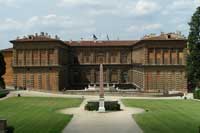 The Pitti Palace |
|||||||||||||||||||||||||||||||||||||||||||||||||||||||||||||
| The Palatine Gallery occupies the whole left wing of the first floor of the Pitti Palace, which was the residence of the Medici grand-dukes. In 1828, when Tuscany came under the rule of the Lorraine family, the most important paintings in the Palace, most of which had been collected by the Medici, were hung in the Gallery. It is an impressive collection comprising works by Raphael, Titian, Correggio, Rubens, Pietro da Cortona and other Italian and European masters of the Renaissance and Baroque periods. The paintings, which are sumptuously framed, cover the walls of the rooms in the style of traditional 17th-century picture galleries. The way they are hung and the rich plaster and fresco decoration of the suite of six rooms overlooking the piazza give the Gallery its particular fascination. From the Palatine Gallery the visit continues through the Royal Apartments. They consist of fourteen magnificent rooms which were the home of the Medici and Lorraine grand-ducal families and, from 1865, of the king of Italy. The 'Museo degli Argenti' (The Medici Treasury) is located in the Summer Apartments on the ground floor and on the mezzanine floor of the Pitti Palace. The Granduke Ferdinando I made these rooms decorated in 1635, on the occasion of his wedding with Vittoria della Rovere. The Museum houses the important Medici’s Treasure: the semi precious stone vases of Lorenzo the Magnificent, the cameos of Cosimo I, the rock crystal objects of Francesco I, the ambers of Maria Maddalena d’Austria, the wonderful ivory vases of Mattia de Medici and the famous jewels collection belonged to Anna Maria Luisa, the last member of the Medici Family. The Museum is named after the silvers of the Salzburg Treasure, belonged to the Bishops of Salzburg and brought to Florence by Ferdinand III of Lorena in 1815. The Museum also houses an important collection of jewels made between the 17th and the 20th century by the most important Italian and European workshops. An important new section devoted to the Contemporary Jewellery has recently been opened to testify the vitality of this historical Museum. A new setting houses the Japanese and Chinese Medici’s porcelain collection, started from the Medici Family in the 15th century: in the same room is now showed another important collection, given to the Museum by the Scalabrino Family, including Japanese and Chinese porcelains and some European maiolicas. On the mezzanine floor of the museum it is possible to visit an extraordinary collection of miniature portraits, executed between the mid-sixteenth and the twentieth century, illustrating the principal schools of production: French, English, Italian, German, Austrian and American. The Porcelain Museum houses the most beautiful porcelain of Europe, bought by Pietro Leopoldo and Ferdinand III: this collection was enriched by the arrival of other porcelain from the historical palaces of Parma, Piacenza and Sala Baganza which, from 1860, had been “sacked” to furnish the Royal Apartments of the Savoia Family in the Pitti Palace in Florence. The Museum is located in the 18th century building called the Palazzina del Cavaliere at the top of the Boboli Gardens. In this pavilion of delights, the Accademici del Cimento gathered and Gian Gastone de Medici took French lessons. Rising behind the Pitti Palace are the beautiful Boboli Gardens. They were originally designed for the Medici and are one of the earliest examples of the Italian Garden which later inspired those of many European courts. The gardens extend over a vast area forming an open-air museum with antique and Renaissance statues, grottoes and large fountains. Exploring its numerous and varied walks one is able to evoke the spirit of life at court and to enjoy the experience of a garden which continues to renew its natural cycle in keeping with the tradition of its past. Art in Tuscany | Palazzo Pitti or The Pitti Palace |
||||||||||||||||||||||||||||||||||||||||||||||||||||||||||||||
The fortress of Belvedere, located on the hill behind the garden of Boboli, is often referred to as «the most beautiful terrace on Florence». Art exhibitions and summer festivals are held here. History |
|
|||||||||||||||||||||||||||||||||||||||||||||||||||||||||||||
|
||||||||||||||||||||||||||||||||||||||||||||||||||||||||||||||

